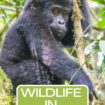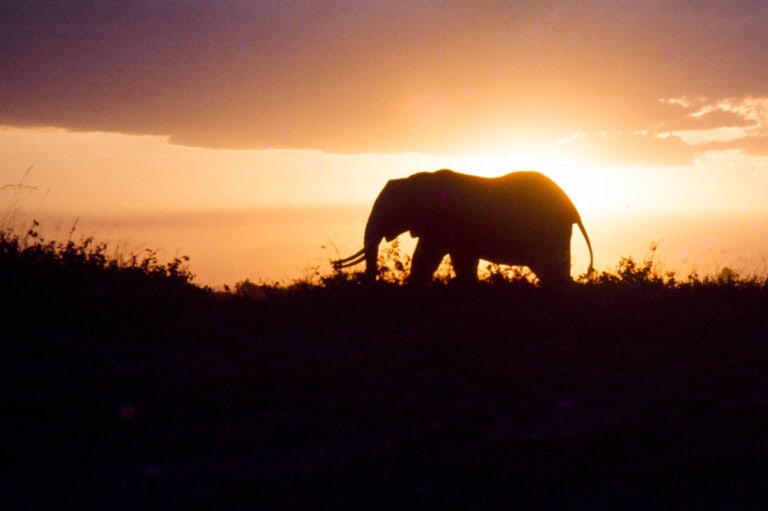
Go World Travel is reader-supported and may earn a commission from purchases made through links in this piece.
The massive silverback gorilla known as Malaya stoops over a rivulet in the Bwindi Impenetrable Forest. Much of his weight is supported by a brawny right arm.
Malaya repeatedly plunges his left hand into the clear brook, bringing the back of the hand to his lips so he can slurp some water.
This is extraordinary. Food such as bamboo shoots provides most of the moisture these animals need. The eminent biologist George Schaller studied them here and nearby in Rwanda for 20 months and never saw a gorilla drink.
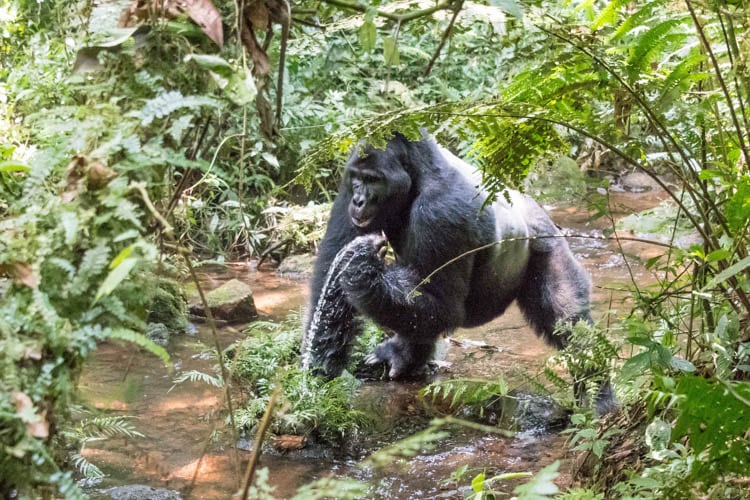
The 28-year-old patriarch of the Makara troop, which includes four moms and four youngsters, is magnificent. I’m much too close, but our guides counseled standing still if a gorilla approaches. I watch just downstream and record the moment with my Nikon.
In December 1971, I climbed Mount Visoke in Rwanda searching for gorillas. While I found spoor—nests and dung—I failed to see or even hear any apes. Hiking the trail into Volcanoes National Park, I encountered the soon-to-be-famous gorilla researcher Dian Fossey.
She was being transported on a litter after suffering a broken ankle. Fossey—who opposed gorilla tourism—essentially ordered me off “her” mountain. I had a permit from park authorities and so ignored her.
My second gorilla experience, in January 2022, was hours long, and the trek almost exceeded my septuagenarian capabilities. Seeing gorillas up close was the apex of my return journey to Uganda after a lapse of 50 years. I was accompanied on this trip by my wife, Marina, and friends Vince and Lise Ciolino.

Dreams of a Vanishing Africa
On my 1971 visit, I explored most of Uganda’s national parks. I had entered Uganda without a valid visa soon after Idi Amin’s coup, but fortunately, God sometimes protects the young and simpletons. Uganda was part of the year-long African adventure recounted in Dreams of a Vanishing Africa: A 1970s Transcontinental Trek.
A half-century ago, handheld gizmos that could instantly communicate across the globe belonged to the realm of science fiction. Digital cameras and vibration-reduction telephoto lens would not be invented for decades.
I traveled on a shoestring, lived out of a backpack, journeyed on decrepit vehicles, and often slept in dodgy locations. But by so doing, I experienced intimately the fabric of African societies.
Best Tips & Tools to Plan Your Trip
This time our group enjoyed considerable creature comforts on an itinerary arranged by Reef and Rainforest in the UK. We stayed in upscale lodgings—often as the only guests, because of Covid—and celebrated gin o’clock for sundowners with Uganda waragi and tonic. And though we had suitable ground transportation, our Landcruiser’s rear axle got mired in mud.
A week later, a rear wheel flew off on a particularly potholed road. Another time, the pontoon on our launch on the Albert Nile leaked so badly that the crew distributed life preservers. Uganda remains unpredictable.
In 1971 guides were uncommon in Uganda and, for me, unaffordable. This time, they were instrumental in enabling us to locate predators, find endangered shoebill storks in a papyrus swamp, and identify elusive birds.
Without trackers in the Bwindi and Kibale parks or had the Uganda Wildlife Authority not spent decades habituating troops of apes to human presence, we would never have experienced the exhilaration of spending time with gorillas and chimpanzees.

How Has Uganda Changed?
Uganda’s population has quadrupled since 1971 and now exceeds 45 million. Kampala’s daytime population is 2.5 million, more than half of whom commute from the capital’s suburbs.
A Chinese company recently built a toll-freeway in the city. Uganda’s surging population seems hazardous to its wildlife, and to the quality of human life there.
Yet Uganda’s ambiance remains unchanged after a half-century. Our Landcruiser rattled over dusty corrugated murram tracks in northern Uganda. These tracks run between national parks in the Kidepo Valley and at Murchison Falls. Crimson ribbons of road still meander through verdant subsistence banana farms.
We passed settlements consisting of family-based clusters of round daub-and-wattle manyattas. Rural schools now seem more common, even ubiquitous.
Many schools board students and advertise on roadside billboards everywhere. Throngs of uniformed youngsters smiled and waved as we passed. Ugandans are welcoming, a common feature of rural Africa that remains unchanged.
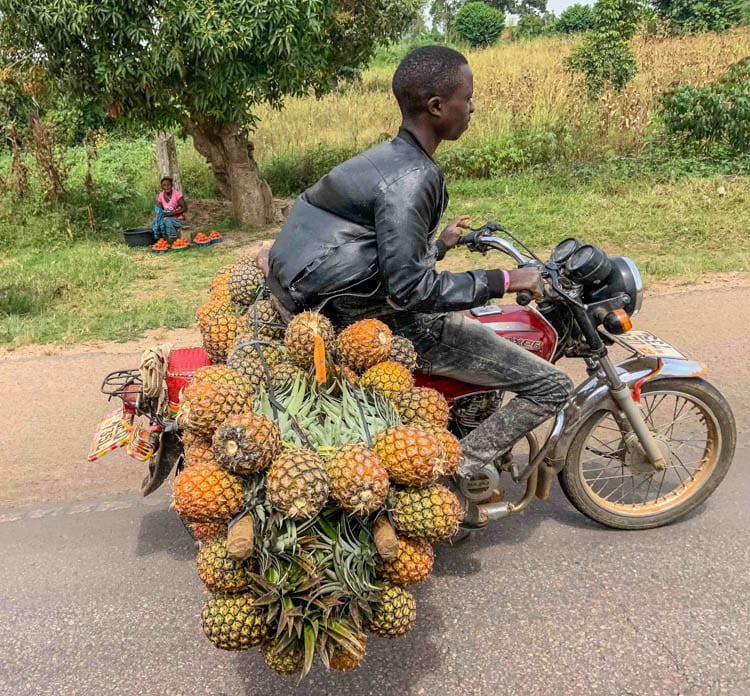
Uganda Today
In western and southern Uganda, traditional huts are being replaced with red-brick, tile-roofed homes. Clay bricks are fabricated in small wood-fired kilns that are common sights along the roadsides.
Many of the main roads are now well-paved replacing the washboard dirt that was commonplace 50 years ago. However, bone-jarring speed bumps do appear inexplicably and frequently. Our driver usually powered over them.
Concrete stores now pockmark the countryside. The fascinating kaleidoscope of roadside life is little changed today. There are vibrant vegetable and fruit stands and goats and sheep grazing on short tethers.
In addition, there are burlap sacks of charcoal for sale, locals clad in gaudy cotton kangas and drying laundry draped on the ground.
Motorbikes, colloquially called boda boda, are new. Typically overloaded, they transport multiple passengers, enormous hands of bananas, furniture, scores of pineapples, and even livestock.
Population growth helps account for the poor air quality most everywhere. The skies were opaque across Uganda during our two-hour Cessna flight from Kampala to Kidepo Valley.
In urban areas, the effluvia of smoldering garbage befouled the air. Farmers burning stubble just before the rainy season contributes to particulate pollution, as does charcoal making and cooking with wood fuel.
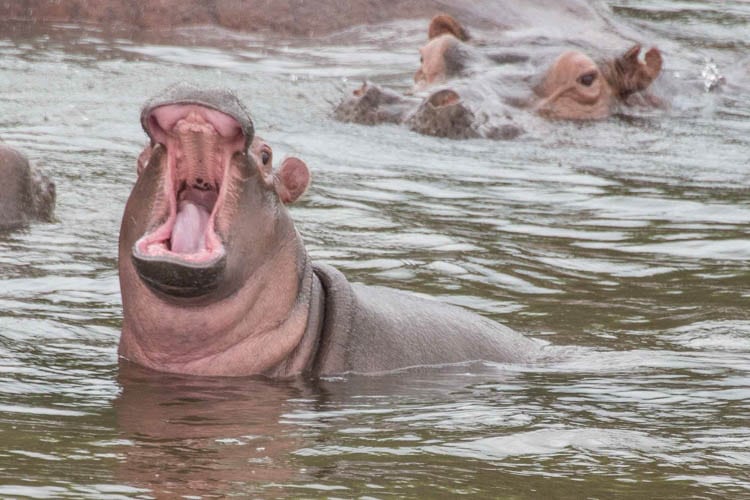
Wildlife in Uganda: Crisis in the 1970s
When I enjoyed Uganda’s national parks and wildlife in 1971, its national parks were the jewels of East Africa. I tent-camped and drove an antiquated Renault to see vast herds of elephants, red-brown Uganda kobs and handsome Rothschild’s giraffes in Queen Elizabeth and Murchison Falls parks.
In 2022, on our Albert Nile launch, we saw huge pods of torpid hippos peering from the lake surface, wiggling their ears and blowing bubbles. The boisterous snorting of water piggies is the voice of Africa’s rivers and lakes. Eighteen-foot-long Nile crocodiles lurked along the riverbanks, their colossal mouths agape. Malachite kingfishers were legion.
In the 1970s Idi Amin ushered in an era of lawlessness that included a gutting of the country’s game-protection system. Soldiers and poachers slaughtered elephants and black rhinos with automatic rifles, mortars and rocket-propelled grenades.
By the mid-1980s, Uganda’s elephant population had collapsed, falling from 30,000 to under two thousand. In addition, black rhinos became essentially extinct. The plains antelope were decimated.
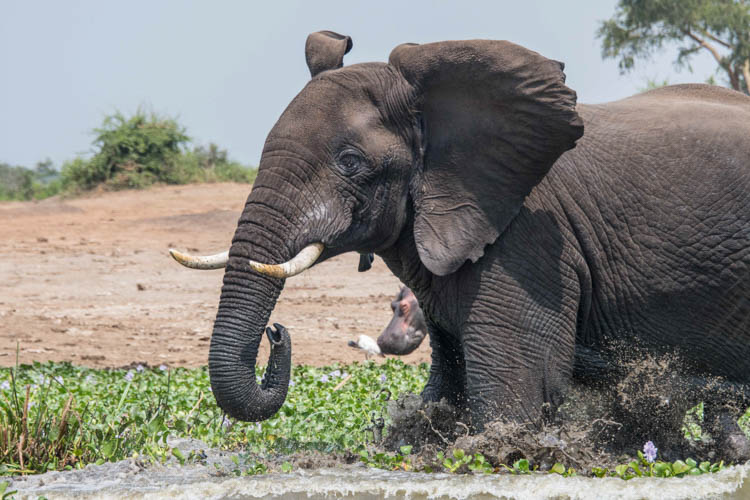
Wildlife in Uganda Has Mostly Recovered
The Uganda Wildlife Authority has done an outstanding job of restoring wildlife in Uganda’s legacy parks and has also established new ones. Besides controlling poaching so that animals can slowly reproduce to regain former levels, the Wildlife Authority has transplanted species that need additional help.
Although most populations have not attained the levels of 50 years ago, they are moving toward full recovery.
Uganda’s elephant population has gradually increased to about 7,000, but they are now limited to parks and adjacent habitats. They lack functional corridors, which restricts elephant migrations and dispersal. Black rhinos remain virtually extinct in the wild, but they may be reintroduced in Kidepo Valley National Park.
While most large animals inhabit only parks, Uganda’s overall wildlife-survival situation is nowhere near as dire as Peter Beard’s gloomy predictions in his 1965 book, The End of the Game.
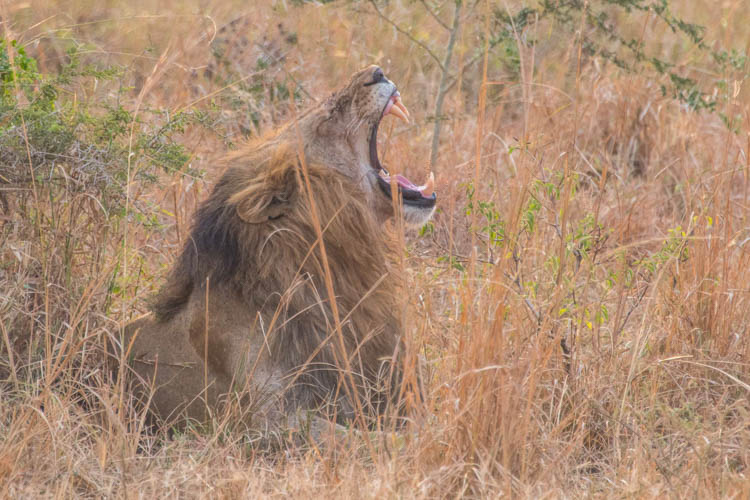
Kidepo Valley
I had been eager to visit Kidepo Valley in 1971, knowing that it teemed with wildlife. But at the time, it was accessible only by four-wheel-drive vehicles via long stretches of barely passable road. My Renault wasn’t up to the task.
Now, in 2022, we flew there from Kampala and stayed at Apoka Lodge, which is perched on a kopje that overlooks the savannah. Hyenas yowled mournfully before dawn. Antelopes and warthogs sipped at the lodge’s waterholes during the heat of the day.
Patrick, an affable Karamojong who grew up nearby, was our guide in Kidepo. He has worked there for 20 years and helped transplant Rothschild’s giraffes, which had been locally extirpated.
Patrick’s local knowledge enabled us to see lions lounging under candelabra trees as well as large numbers of elephants, plains zebras, giraffes and antelopes.
He drove us one evening to seek elusive pangolins, but an unseasonable downpour intervened. Cape buffalo were ubiquitous, numbering about 13,000, and we saw herds of a thousand or more.
At some point, Kidepo may become a multinational park that would encompass protected areas in South Sudan and northwestern Kenya. This could facilitate the migrations of elephants, zebras and antelopes.
Brian Tuhaise met us in Kidepo and was our driver-guide for the rest of the journey. The head of the Uganda Safari Guides Association, Brian can, it seems, identify any bird. Murchison Falls—where the Nile tumbles 400 feet through a 20-foot-wide rock gorge—is a symbol of Uganda. The launch trip we took on the White Nile seemed little changed after a half-century.
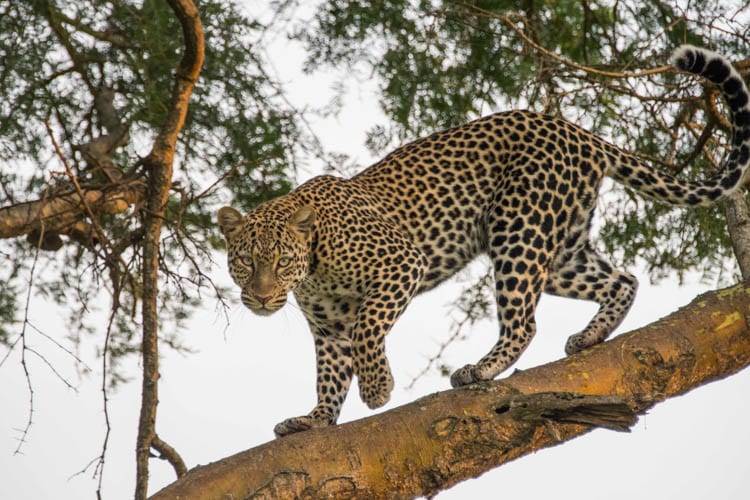
Poachers Still Threaten Wildlife in Uganda
Hippos remain abundant, although the crocodiles that survived the poaching era are not as enormous as the 70- to 80-year-old leviathans I recall.
The herds of kobs and waterbucks seem to have attained their former abundance. However, elephants are much less common than they were 50 years ago. And we picked up some danger signs.
This included an elephant whose trunk was a foot shorter than normal because of a painful encounter with a poacher’s snare. Giant bulldozers were clearing the way for a massive road within Murchison Falls Park to service oil development.
South of Murchison Falls, the wildlife in Queen Elizabeth Park has changed little in a half-century. Although, as elsewhere, there are fewer elephants. We saw no truly long-tusked males, and it may take decades before elephants live long enough to grow 150-pound tusks again.
Poachers’ snares are a problem, exacerbated by subsistence villages located within the park. The park’s veterinarians treat the wounds of elephants and other injured creatures.
Queen Elizabeth’s Ishasha sector, near Lake Edward, is magical, sporting some of the most fetching landscapes in Africa. Brian led us to sight tree-climbing lions, elephants chasing spotted hyenas and trees festooned with crowned cranes (Uganda’s national bird). Plus, a leopard asleep in an acacia tree.
The Ishasha River forms the boundary with the Democratic Republic of Congo, near a border post where I entered Uganda from the Congo in 1971. Today, the Ugandan army has an encampment here, a reminder of rebel incursions from a troubled Congo. The armed guards who accompany us on our treks are there to protect us both from wildlife and humans.
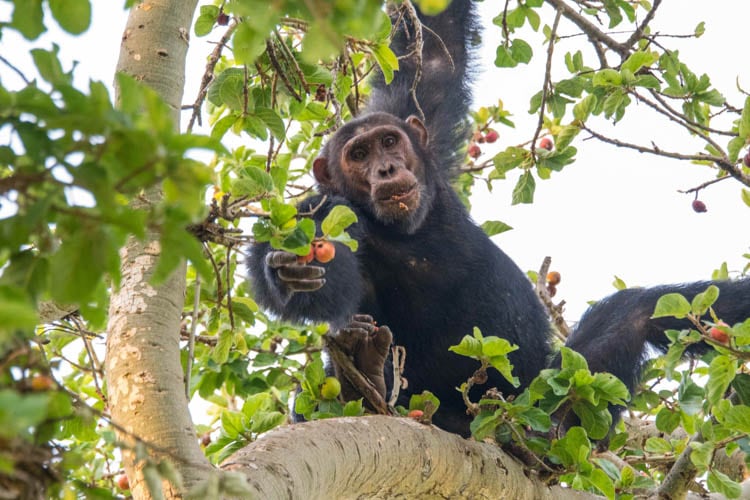
Kibale Forest and Bwindi Impenetrable Forest
Fifty years ago, I never entered Kibale Forest or the Bwindi Impenetrable Forest. These were not designated as parks until the 1990s. Trekking in Kibale to see chimpanzees and Bwindi to see gorillas was reminiscent of my experience with BaMbuti Pygmies in Congo’s Ituri Forest in 1971.
The floors of rainforests are strewn with vines, roots and rotting branches. Our guides swung pangas to hack away minor undergrowth. Without them, we would have become hopelessly lost because, for us, the foliage was trackless and lacked landmarks.
In the Kibale Forest, we mingled with a troop of a dozen chimpanzees for several hours. Eventually, the alpha male ambled down the trail to where we stood motionless and passed by so close that he brushed against my trousers.
To the amusement of Marina, Vince and Lise, he passed gas and pooped, almost hitting my foot. I remained frozen in place until he sauntered off a few minutes later. The warden explained that the chimp was taking my measure and responding to the challenge I posed as a rival white-haired ape. It was gratifying on my return to Uganda to be considered an honorary silverback.

Book This Trip
Ready to plan your Ugandan wildlife escape? Start planning with knowledge on how to get around, hotel and VRBO accommodations, local restaurant reviews and more through TripAdvisor and Travelocity.
Be sure to pack all your travel essentials and still have room for some shopping with reliable, stylish and expandable luggage from AWAY Travel Bags. Check out their selection of top-rated travel bags here.
Author Bio: Craig S. Harrison lives in Santa Rosa, California. He is the author of Dreams of a Vanishing Africa: A 1970s Transcontinental Trek
- Fiddle, Flutes & Pubs: A Musical Journey Through Northern Ireland & County Donegal - July 14, 2025
- Tokyo vs. Osaka: The Ultimate Face-Off for First-Time Visitors to Japan - July 14, 2025
- When Is the Best Time to Visit Iceland? Find Your Perfect Month for Budget, Weather, and Activities - July 14, 2025

